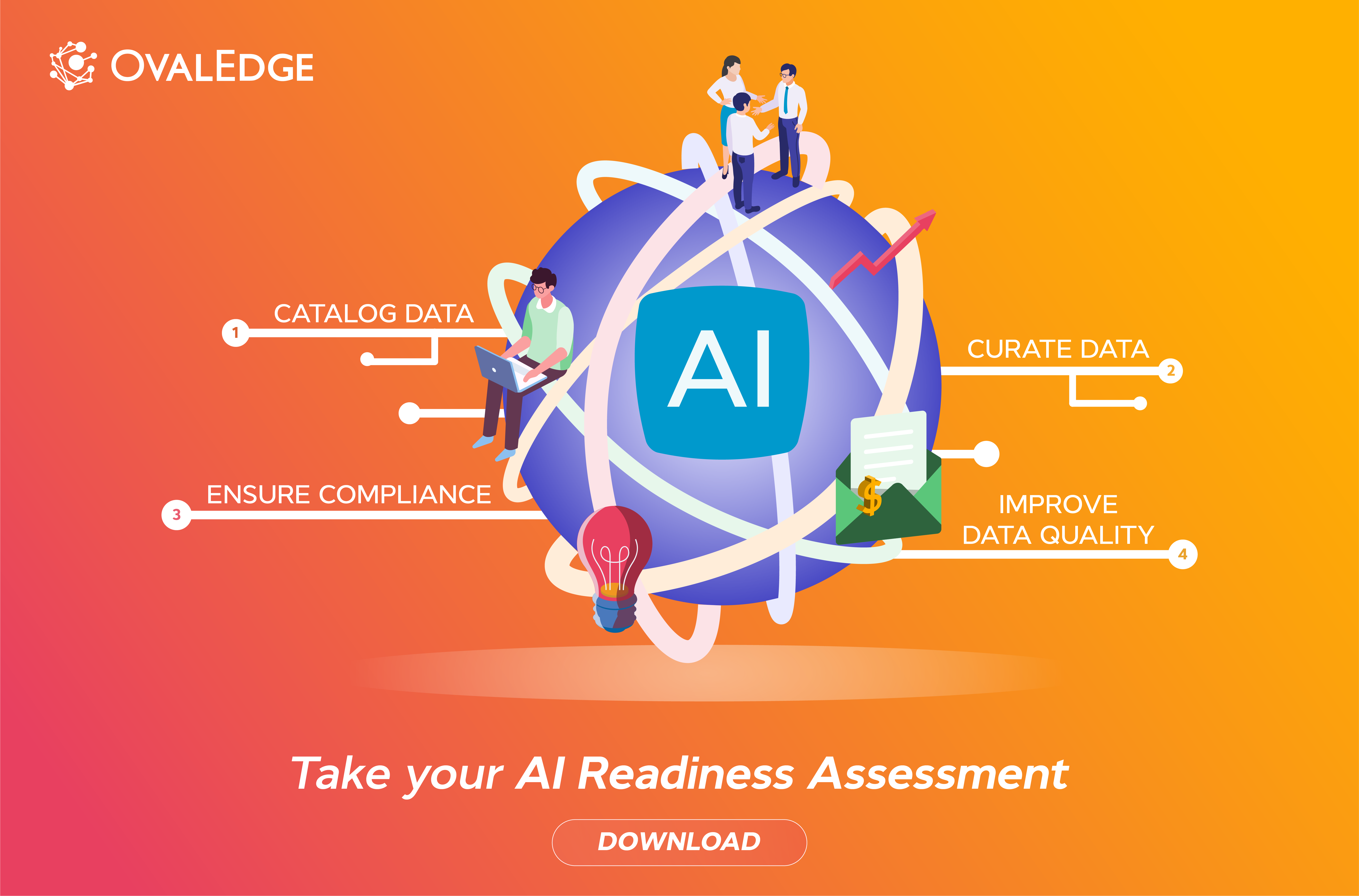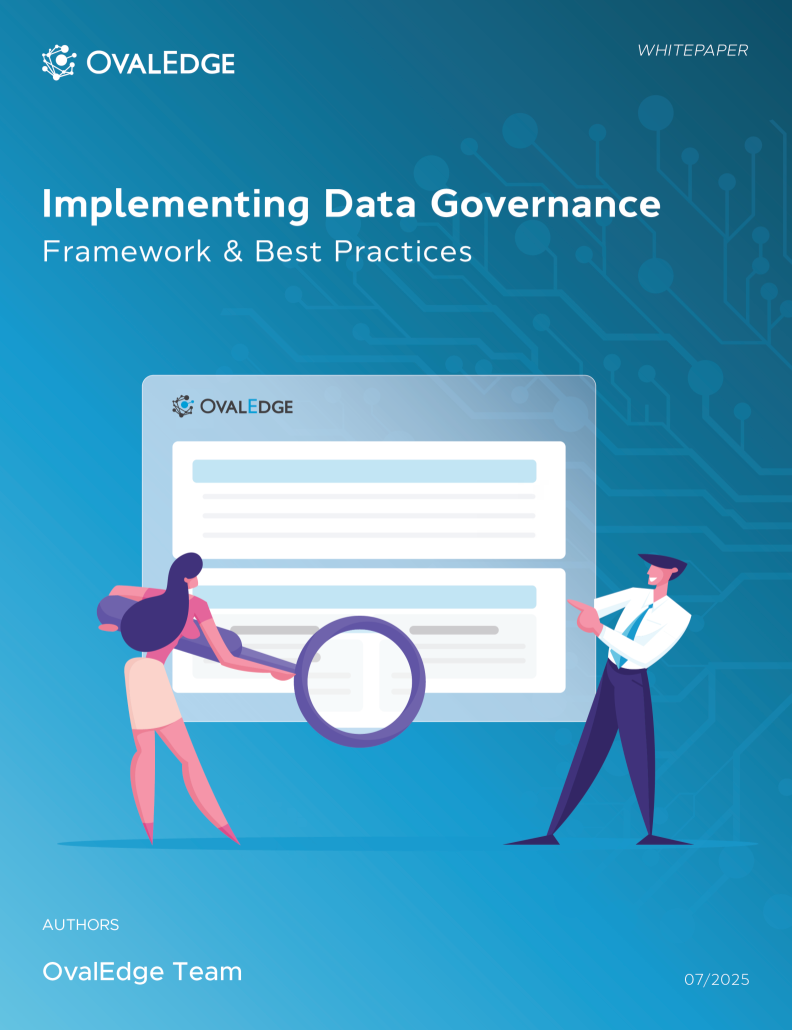Table of Contents
How to Make Data AI-Ready: 4 Essential Steps for 2026
The real question many leaders are asking today is: Is your data ready for AI? Or more directly, is your data AI-ready?
If not, you’re not alone. While 55% of companies have adopted AI, many still struggle with messy, unorganized data that slows down AI projects. Whether you’re building predictive models or enhancing customer experiences, preparing your data is step one.
In this blog, we’ll break down the four critical steps to making your data AI-ready, from cataloging and curating to ensuring compliance and improving data quality.
Related Post : Data Governance Tools: Capabilities To Look For
What is AI Readiness?
AI readiness is a broad concept that touches every aspect of your organization's culture, infrastructure, people, and processes. But at its core, it answers a simple question:
👉 What is AI-ready data?
AI-ready data is data that is clean, organized, well-documented, compliant, and easy for data scientists to access and use for AI modeling.
Many organizations struggle because they do not have full-time data scientists. Instead, they rely on consultants or part-time teams, which leads to major challenges:
- Costly delays: The longer it takes experts to clean and interpret your data, the more expensive your AI project becomes.
- Competitive risk: While your teams are fixing your data, competitors may already be launching AI-powered solutions.
So if you're wondering how to make data AI-ready, the answer lies in removing these bottlenecks quickly and building a strong data foundation.
4 Steps to Make AI-Ready Data
1. Creating a Data Catalog
Imagine a kitchen with all your ingredients spread across different cabinets, some in the pantry, others in the fridge. Cooking a meal becomes a headache. Similarly, when your data is scattered across different systems, it’s hard for data scientists to work efficiently.
Why it matters:
Most companies have data spread across various repositories (data warehouses, departments, etc.), making it difficult to find and use.
How to fix it:
Build a centralized data catalog. Tools like OvalEdge's data catalog can crawl through your data and create a single place where all your data is accessible and organized.
A data catalog not only locates your data; it also adds context. It is like labeling ingredients in a pantry, it ensures data scientists understand what they’re working with.
Related Post: How to Build a Data Catalog
2. Classify and Curate Your Data
Once your data is cataloged, the next step is to curate it. Curation means organizing your data in a way that makes it easy to find and understand.
Why it matters:
Without context, data is like ingredients without labels—hard to use! Curation helps ensure data is correctly organized for AI projects.
Key Benefits:
- Data becomes easier to find and prioritize.
- Data teams and business teams gain access to important contextual information, like who owns the data and what it’s used for.
- AI models can be built faster, reducing the time to market.
Manual curation can be time-consuming, especially with large datasets. Fortunately, AI-driven tools like OvalEdge can speed up the process by automatically classifying data.
But don’t forget to involve business teams, technical curation alone won’t provide the business context that’s crucial for AI
3. Ensure Data Compliance
In today’s world, ignoring data privacy regulations can be disastrous. AI models often handle sensitive information like personal customer data, which makes compliance a critical step.
Here’s why compliance is important:
- Avoid costly fines: Laws like GDPR and CCPA require companies to protect personal data. Failing to comply can lead to massive fines.
- Ensure global scalability: AI models used across different regions must comply with local regulations. A model built for the U.S. might not meet the strict data privacy rules in Europe, for example.
How to stay compliant:
- Curation tools: Flag sensitive data like Personally Identifiable Information (PII) during the curation process.
- Keep records: Ensure data scientists know which datasets can be used and under what conditions.
Real-world example:
Clearview AI was fined €20 million for violating GDPR by collecting facial images without consent, demonstrating the costly impact of ignoring regional data laws. Proper data governance could have prevented this breach, ensuring compliance and avoiding penalties.
Related Whitepaper: How to Ensure Data Privacy Compliance with OvalEdge
4. Data Quality Improvement
While organizing and cataloging your data is essential, improving data quality is the long-term goal for AI success.
Why it matters:
AI models perform best when trained on high-quality data. However, data scientists can still work with less-than-perfect data in the early stages, provided it’s organized and accessible.
Quick wins:
- Catalog and curate first: Ensure your data is accessible and well-organized upfront.
- Teach data scientists to spot quality data: Training your team to identify the best data available will improve the initial AI models.
Over time, invest in data quality improvement through better processes, policies, and governance. Like sourcing the freshest ingredients for a meal, this takes time, but the results are worth it.
FAQs
1. What is AI-ready data?
AI-ready data is clean, well-organized, documented, compliant, and easy for data teams to access and use. In short, it’s the type of data needed to support reliable AI and ML models.
2. How do I make my data AI-ready?
To make your data AI-ready, start by cataloging your data, classifying and curating it, ensuring compliance, and improving data quality across systems.
3. How can I tell if my data is ready for AI?
Ask: Is your data ready for AI? If your data is scattered, undocumented, inconsistent, or lacks clear ownership, your organization isn’t AI-ready yet.
4. Why does data quality matter for AI?
High-quality data improves model accuracy, reduces training time, and prevents errors. AI models trained on poor-quality data deliver unreliable outcomes.
5. What are the biggest challenges in preparing data for AI?
Common challenges include siloed data, lack of documentation, inconsistent quality, regulatory constraints, and limited data governance maturity.
Conclusion
AI has the potential to transform your business, but only if your data is ready.
Commercial large language models (LLMs), like OpenAI, are a commodity fuelled by generic data. While originally, these models will have been trained on exceptionally high-quality data, over time, this quality has degraded as the models have relied on user-generated internet data for training.
That's why they must be enhanced with proprietary data. By following these four essential steps: creating a data catalog, curating your data, ensuring compliance, and improving data quality, you can unlock the true power of AI. Companies that act quickly will gain a competitive edge, while those that delay risk falling behind.
👉 Is your data ready for AI?
If not, now is the time to fix it.
OvalEdge recognized as a leader in data governance solutions
.png?width=1081&height=173&name=Forrester%201%20(1).png)
“Reference customers have repeatedly mentioned the great customer service they receive along with the support for their custom requirements, facilitating time to value. OvalEdge fits well with organizations prioritizing business user empowerment within their data governance strategy.”
.png?width=1081&height=241&name=KC%20-%20Logo%201%20(1).png)
“Reference customers have repeatedly mentioned the great customer service they receive along with the support for their custom requirements, facilitating time to value. OvalEdge fits well with organizations prioritizing business user empowerment within their data governance strategy.”
Gartner, Magic Quadrant for Data and Analytics Governance Platforms, January 2025
Gartner does not endorse any vendor, product or service depicted in its research publications, and does not advise technology users to select only those vendors with the highest ratings or other designation. Gartner research publications consist of the opinions of Gartner’s research organization and should not be construed as statements of fact. Gartner disclaims all warranties, expressed or implied, with respect to this research, including any warranties of merchantability or fitness for a particular purpose.
GARTNER and MAGIC QUADRANT are registered trademarks of Gartner, Inc. and/or its affiliates in the U.S. and internationally and are used herein with permission. All rights reserved.



.webp)


